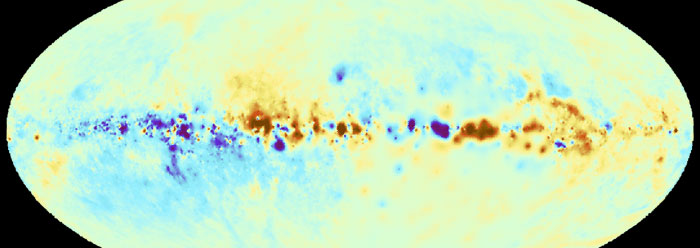Secular astronomers are no closer to understanding what could cause galactic magnetic fields than they were when they first detected the fields over a century ago. And although the most recent map of the Milky Way's magnetic field shows unprecedented detail, it gives no clues to the question of magnetic field formation through natural forces. Did this field require a Creator for its origin?
An international team of radio astronomers compiled over 41,000 radio signals that had travelled through the Milky Way galaxy from distant stars to earth. The team applied an algorithm to the stellar data to help resolve the degree of twisting—called the Faraday effect—that the Milky Way induced on the radio light. The researchers inferred and mapped the strength and distribution of magnetism across the sky, showing areas of positive and negative field lines in the Milky Way galaxy.
But why would a galaxy have a magnetic field?
Secular theories of magnetic field formation usually invoke a dynamo that converts mechanical rotation into magnetism. But such devices require precisely fitted parts made of just the right materials moving at just the right speeds, like in a car's alternator. No direct evidence shows that such devices exist in planets, stars, or galaxies.
"Until now, scientists have been puzzled over the origin of these galactic magnetic fields. The assumption was that the magnetic fields were created by processes where mechanical energy is converted into magnetic energy," according to a U.S. Naval Research Laboratory news release on the Milky Way map.1
Does the new magnetic sky map help explain how some natural phenomenon is producing magnetism? No, it does not.
Instead, "the map that the team has created will give scientists valuable knowledge about the structure of Galactic magnetic fields throughout the Milky Way."1 And while science can observe and scrutinize the structure of an object, deducing that object's origin requires different tools.
"With this new data, researchers will be able to provide updates to the image of the Faraday sky, and perhaps someday understand the origin of the galactic magnetic fields."1 But more detailed information of this enormous magnetic field will yield no better theories of its formation than a more detailed dissection of every car part would yield better theories of how nature may have built a car. In other words, more observations will not necessarily answer the origins question.
In 2008, physicist D. Russell Humphreys proposed a Bible-centered model for the origin of magnetic fields that is consistent with the overall strength of the spiral Milky Way's magnetic field.2 If God formed the stars and galaxies during the fourth day of creation using water that He had created earlier, and if those water molecules were all originally aligned, their tiny magnetic fields would have combined to form a galactic magnetic field that has decayed to something that looks like today's observed field strength.
Humphreys summarized the problem with nature-only (uniformitarian) theories of galaxy origins in a technical paper describing how his model applies to galactic magnetic fields. He wrote:
To preserve both the physical and magnetic spirals for billions of years, uniformitarians have devised two complex theories: (1) "density waves" (concentrating or spreading stars) and (2) "galactic dynamos" (complex flows of plasma and stars generating magnetic fields). Neither theory has gotten much further than the hand-waving stage. Moreover, they do not seem to be compatible with each other. For example, the waves of density would not move stars and plasma with them any more than waves in a pond move floating corks.2
In contrast, Humphreys argued, a Creator "God may have left us magnetic fields in the heavens as evidence of His handiwork."2
References
- Scientists Chart High-Precision Map of Milky Way's Magnetic Fields. U.S. Naval Research Laboratory news release, February 3, 2012.
- Humphreys, D. R. 2008. The Creation of Cosmic Magnetic Fields. In Proceedings of the Sixth International Conference on Creationism. A. A. Snelling, ed. Pittsburgh, PA: Creation Science Fellowship and Dallas, TX: Institute for Creation Research, 213-230.
Image credit: Max Planck Institute for Astrophysics, Garching, Germany
* Mr. Thomas is Science Writer at the Institute for Creation Research.
Article posted on February 29, 2012.





















